20. Jun 2024 - DOI 10.25626/0149
Naum Trajanovski is an adjunct faculty member at the Faculty of Sociology, University of Warsaw. He is currently working on the research project “Towards Illiberal Constitutionalism in East Central Europe: Historical Analysis in Comparative and Transnational Perspectives.” He holds a PhD in sociology from the Institute of Philosophy and Sociology at the Polish Academy of Sciences. His major academic interests include historical sociology, the history of sociology in East Central and Southeast Europe, nationalism, and memory studies. He recently published the monograph A History of Macedonian Sociology: In Quest for Identity (Palgrave Macmillan, 2024).
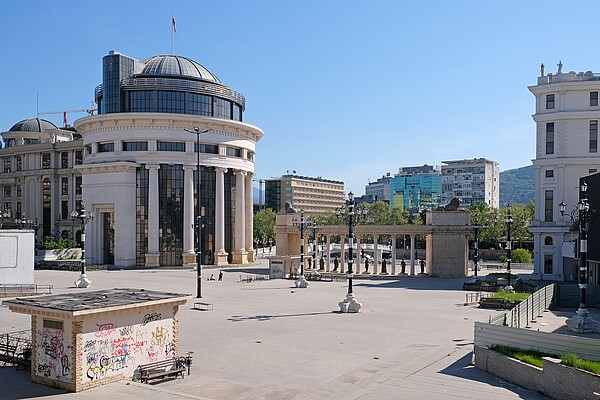
On 20 September 2023, Skopje was named the 2028 European Capital of Culture alongside Bourges and České Budějovice. Amidst the excitement, the news renewed a debate within North Macedonia about the capital city’s past, present, and potential futures, and how they might be influenced by the award. Common to all positions in the debate was that they referred, in one way or another, to the Skopje 2014 project, which encompassed the construction of more than 130 new memorial objects, buildings, and facades over the course of several years. Beginning in the early 2010s, the project radically changed Skopje’s central urban landscape and – as a previous contributor to this forum has argued – the city’s identity. Just as the European Capital of Culture application process started in 2014, the preparations for and realization of the Skopje 2014 project spanned several coalitions both in national and local government. Accordingly, it was influenced by their differing political visions for Skopje and Skopjans. Power shifted from the project’s proponents to its opponents, who won elections campaigning for its reassessment and eventual cancellation, and back to its proponents once again. But like it or not, Skopje 2014 is here to stay. What remains uncertain at the tenth anniversary of its planned (but yet to be fulfilled) completion, however, is how it will be managed over the next few years and the official narrative about it as the city looks ahead to 2028. This article maps the latest critical events pertaining to the Skopje 2014 project and discusses its legacy after nearly fifteen years.
The origins of the Skopje 2014 project date back to April 2008, when – despite general support for Macedonia’s admission – Greece blocked the Macedonian bid to join NATO at its summit in Bucharest due to the longstanding, unresolved bilateral dispute about the name of the Republic of Macedonia. Faced with this harsh reality of international politics, the centre-right Macedonian government led by the VMRO-DPMNE party and its leader Nikola Gruevski showed no intention of throwing in the towel.[1] After the debacle, Macedonia tightened relations with the United States and filed a lawsuit against the Greek government at the International Court of Justice. In 2011, Macedonia won the case, but this did little to resolve the dispute and further Macedonia’s goal of joining NATO and the European Union. To appease his constituency, Gruevski and his inner circle announced at a now infamous press conference in February 2010 – without any prior public debate – the decision to fill the capital city with memorials of events and figures in Macedonian history from Antiquity to the present. The subtext was that tensions with neighbours would be unable to stop the domestic promotion of what the country’s leaders considered to be defining elements of national identity (discussed below).
From today’s perspective, the planned urban revamping, publicized from its beginnings as the Skopje 2014 project, marked the political recalibration of the VMRO-DPMNE during its second cabinet from technocratic conservativism (2006–2008) to nativist populism and illiberalism (2008–2016). After the party lost the 2002 elections, Gruevski, who was Minister of Finance in the first cabinet (1998–2002), became party leader and gained international partners’ trust as a young economist uninterested in engaging in the politics of history. His platform for the 2006 elections marked a clear departure from VMRO-DPMNE’s ethnonationalism in the late 1990s. It only marginally touched on revisiting the state’s socialist past, which was in line with the political agenda of the Central and East Central European right of the day, with whom VMRO-DPMNE was and still is allied. Nonetheless, while the Skopje 2014 project’s most visible (at first glance, at least) act of historical revisionism was its representation of Macedonia as the rightful heir of Antiquity – a direct attack against Greece – the partisan vision of late modern and contemporary Macedonian nation-building was equally if not more instrumental for the project’s weaponization of history and memory. My recently published chapter analysing visitors’ comments at the Museum of the Macedonian Struggle – one of the flagship institutions of the Skopje 2014 project – offers a neat illustration of this point. The exhibition on the recurrence of armed struggle in Macedonian history cast Macedonians as victims and was presented as a something that had long been concealed from ethnic Macedonians. This in turn provoked affective reactions and contributed to visitors scapegoating partisan others, be it the political opposition, neighbouring states or the international community.
By the late 2000s, however, it became evident that the Skopje 2014 project was neither a project, nor was it exclusively concerned with Skopje or 2014. To begin with, it was never legally defined as a project, and its authors as well as its final costs – speculated to be over seven times the initially planned amount of 80 million euros – remained unknown. Although many had conjectured that Skopje 2014 was ridden with irregularities, they only began to be publicized after the opposition SDSM party won elections in Skopje’s Centar Municipality, where the majority of objects are located.[2] In 2014, the irregularities started to be noted in the European Commission’s reports on the country’s progress towards EU accession. In 2018, after North Macedonia’s national government changed composition, a joint body of state and non-governmental actors depicted Skopje 2014 as “a product and an embodiment of the very concept of a state capture”. In addition, since 2010, a number of memorials and memory institutions associated with Skopje 2014 have been constructed outside the borders of Skopje proper. Finally, the project was far from finished in 2014, and construction continues to this very day. The half-completed Officers’ Hall at the city’s central square, which was destroyed in the calamitous Skopje earthquake in 1963 and the reconstruction of which was announced in 2013, underscores this well for even the most uninformed visitor.
Much has been written about Skopje 2014 in the past years. In a chapter I published in 2021, I sought to summarize domestic takes on Skopje 2014 and the major events impacting the public discourse since it was publicized. In brief, public debate became possible only after the SDSM party’s aforementioned electoral win in the Centar district in 2013; however, the municipality’s government had little power to influence construction. In this context, scholarly interventions shifted from discussing antiquization to the project’s potential to mobilize voters, its role in the deterioration of interethnic relations in the city and its complex relations with the urban heritage. The most recent expert positions have remained critical and have analysed in particular the neoliberal logic at work in the reconfiguration and privatization of public space. Skopje and Skopje 2014 thus became symbols for the failures to resist the corrupt schemes targeting the cities in the region, which have a longer history dating back to local governance in state socialism and the immediate post-socialist period. For instance, the similar recent takeover of public space in Belgrade has been compared to Skopje, as has the deterioration of the urban fabric of Zagreb. In recent years, the “chaotic monument-building boom” experienced by Skopje was also observed in Kosovo, Montenegro, and Bosnia and Herzegovina. And like Skopje, in all of these countries it is also impossible to establish exactly how much public money has been spent on nationalist memorials. Meanwhile, Bulgaria’s model of urban development and aesthetics have been dubbed “mafia baroque”.
Now marking the tenth anniversary of its planned completion, Skopje 2014’s symbolic capital has proven itself to be just as potent as its resistance to any major changes, despite the fact that the memorials and buildings are already crumbling due to botched construction.
Skopje 2014 survived, almost intact, the governmental change following the 2016 parliamentary elections. Initially, the social democrats picked up on the looming public resentment against it. Widely perceived as an embodiment of the second VMRO-DPMNE government, the new objects were colour-bombed during the long protest waves in 2015 and 2016 against the government and the VMRO-DPMNE-backed president following the massive wiretapping scandal. Although the new cabinet led by the social democrats established expert-led parliamentary commissions on Skopje 2014, they proved incapable of acting on these experts’ recommendations. The new national and, as of 2017, local authorities performed symbolic gestures, removing only one Skopje 2014 monument, which depicted an assassin ‘in action’ in front of Skopje’s Primary Court, and reopening a memorial to the armoury of the antifascist resistance in the Second World War. The armoury is very close to the main square, and it had served as a museal site since the late socialist era before becoming surrounded with Skopje 2014 objects. As yet another symbolic gesture, the social democratic cabinet removed the fence that had been erected around the seat of the Assembly of North Macedonia as part of its Skopje 2014 makeover.
Unofficially, the hesitation to change or reverse Skopje 2014 was deemed to stem from the fear of revolt, while officially, the new government claimed that altering Skopje 2014 would be expensive, thus hinting that their position on public expenditures contrasted with that of the previous government.
The real reason was revealed to be something entirely different, however. In 2017, the new cabinet signed a Friendship Treaty with Bulgaria before settling the name issue with Greece in 2018. Both accords were reached in the name of furthering the state’s NATO and EU prospects. They also involved collaborations with both countries as well as the establishment of bilateral expert commissions to review problematic portrayals of one another in each country’s school textbooks. Surprisingly enough, the Greco-Macedonian agreement stipulated a clear understanding about Macedonia and Macedonians between the two parties, which had interesting implications for Skopje 2014. Per Article 7(4), the two parties agreed “that the official language and other attributes of the Second Party [North Macedonia] are not related to the ancient Hellenic civilization, history, culture and heritage of the northern region of the First Party [Greece]”. But a diplomatic compromise – only communicated to the public after it was agreed upon – allowed the Skopje 2014 objects representing the Hellenistic period to be renamed and not removed. The new solution was also a peculiar reversal of the emerging expert-centred approach to the dubious legacy of Skopje 2014. For instance, the most massive ‘Warrior on a Horse’ monument from the main city square finally got its intended name, “Alexander the Great”, and a corresponding descriptive plaque depicting it as Hellenic and a world cultural heritage. The full article stipulating the “corrective action” reads:
Within six months following the entry into force of this Agreement, the Second Party [Republic of North Macedonia] shall review the status of monuments, public buildings and infrastructures on its territory, and insofar as they refer in any way to ancient Hellenic history and civilization constituting an integral component of the historic or cultural patrimony of the First Party [Republic of Greece], shall take appropriate corrective action to effectively address the issue and ensure respect for the said patrimony.
Skopje 2014 hence survived its first change in government by functioning as a token in bilateral negotiations over the state’s name.
In October 2017, the citizens of Skopje voted for a new city mayor, thus removing the VMRO-DPMNE politician who had held the office since 2009. The new social democratic mayor shifted the focus of its administration away from Skopje 2014 by suspending the construction of almost 100 baroque facades in the central area, changing street names introduced during the previous administration and revising the city’s European Capital of Culture application to show the different faces of Skopje, now dubbed by many as the capital of kitsch. However, his team’s capacity to act was mostly subordinated to the aforementioned decisions of the national government. As more time passed, the more the Skopje 2014 project’s power to resist change was solidifying in public perception. Meanwhile, in 2020, tensions with Bulgaria escalated, which eventually led to Bulgaria’s de facto veto of North Macedonia’s accession to the EU, which lasted until 2022. The alleged concessions that North Macedonia made became pivotal aspects of the opposition’s campaign in the 2021 local elections, which eventually paved the way for the VMRO-DPMNE to win the majority in the Skopje city council, while the independent candidate the party backed became mayor.
Skopje 2014 thus entered uncharted waters. After an initial period of cooperation between the new council majority and mayor, their relations deteriorated in less than half a year over issues pertaining to political appointments and public services. This spurred the new mayor to look for support from parties and voters from across the political spectrum. Ultimately, these dynamics brought about a number of contradictory developments related to Skopje 2014 in particular and the memory politics in the city in general. For instance, in late 2021, the city administration stopped the council majority from bringing back the street names set during the early 2010s, many of which referred to historical figures from the ancient past. However, by the middle of 2023, the very same administration proposed the return not only of those street names but also of the Skopje 2014 monument of the assassin that had been removed by the previous administration. Though still pending, these moves, alongside changes to the criminal code that caused the statute of limitations to expire for several cases related to the implementation of Skopje 2014, contributed to a peculiar, unexpected shift: even the few Skopje 2014 objects and names that had been removed are being reintroduced, while the memory of their history as well as the accountability of their initiators fade away.
Contemporary Skopje is hence left not only with the material legacy, but also with the messages of the Skopje 2014 project. Moreover, some of them resonate with greater intensity today than they did in the 2010s.
On the one hand, the project was embedded in the public space to the extent that one can question whether the city of Skopje and Skopje 2014 can really be separated at this point. The borders of Skopje 2014 and the urban fabric are becoming more and more blurred, and residents are thus becoming accustomed to it, while the lack of a timely intervention made the idea of establishing a sort of a cordon sanitaire around its objects virtually impossible. Hence, it might be more productive to deal with its particular elements, be it in a spatial, architectonic or symbolic sense. An example of this kind of approach could be seen in North Macedonia’s entry for the 2018 Venice Biennale of Architecture. Titled “Freeingspace”, the exhibit aimed to “reclaim public space” by reimagining four Skopje 2014 objects: the Macedonian Opera and Ballet’s foundation alongside the Vardar River’s quay; Sobranie Palace, the seat of the Assembly of North Macedonia; the Post and Telecommunication Centre; and the NAMA shopping mall at Macedonia Square. Against the backdrop of critical voices calling for an overhaul of the city’s urban planning, the exhibition showcased concrete, although limited, visions of how the city’s architecture and urban design might be restored or pointed in a new direction.
On the other hand, Skopje 2014 unarguably remains the most curious case of a nation-branding makeover in the Balkans (and beyond) of the twenty-first century. The only possible holistic intervention might be to rethink the official narrative of Skopje 2014 and the problematic history of its development, ideology and placement. However, unlike partial approaches such as “Freeingspace” or the frequent invocations of Skopje 2014 as a means of bashing one’s political rivals, a critique of narratives would require more political self-reflection and strategic thinking. Historicizing the narrative around Skopje 2014 would also strip away some criticisms’ tendency to present a revision or reversal of Skopje 2014 as a ready-made answer to all of the city’s pressing urban issues, which are legion.[3] This task is immensely challenging in the context of recent public debates over history and memory in North Macedonia, such as the aforementioned tensions with Bulgaria and the memory culture around the internal armed conflict in 2001. In the latter case, Skopje 2014 set a precedent for an exclusivist appropriation of public space and provided a model for communicating ethnocentric and nationalist messages in public. For instance, in 2012, Skanderbeg Square was opened to the public with great pomp. Located near Skopje’s main square in a municipality dominated by ethnic Albanians, the square was not part of Skopje 2014, but it mirrored its aesthetic mode by displaying elements of Albanian national martyrology.
One possible way forward could be to emphasize the various episodes of civil solidarity provoked by Skopje 2014. Skopje represents one of the rare cases of a European city where many residents witnessed two massive urban reconstruction projects in their lifespans, namely Skopje 2014 and the post-1963 earthquake urban reconstruction. Although certain centripetal tendencies of the Skopjan religious and ethnic communities could already be witnessed in the mid-1960s, many domestic and foreign experts observed that Skopje 2014 conclusively demarcated the boundaries between the city’s ethnic territories. However, these factors proved to be incapable of stopping the formation of a transethnic front against the political usurpation of public space in Skopje, such as in the 2013 citizens’ initiative “I love GTC” (Go sakam GTC), which was ultimately successful in saving a modernist object – one of the emblems of the post-earthquake reconstruction of the city – from a neoclassicist facelift. Thus, prior to the sixty-five-year anniversary of the earthquake in 2028 and in the midst of rising nationalist euphoria in the region and beyond, critiquing Skopje 2014 provides a perfect opportunity to expose nationalist imaginaries and their aesthetic, political and social manifestations.
Most recently, the new VMRO-DPMNE president of North Macedonia, Gordana Siljanovska-Davkova, sparked tensions by avoiding usage of the state’s constitutional name during the presidential inauguration in May 2024. This manoeuvre embodies VMRO-DPMNE’s hard line against both Bulgaria’s demands that North Macedonia’s constitution include references to the “Bulgarian community” and against the country’s name change, both of which were agreed upon during the SDSM government. This hardline approach eventually contributed to their win in the parliamentary elections in 2024. The responses from Greece and the international community to the new president’s usage of “Macedonia” rather than “North Macedonia” in her inauguration speech were harsh, providing a stark warning that the state might face isolation if it continues on this path. In this very context of reinvigorated regional tensions over history and memory and an anticipated shift towards securitization, the prospects of a more structured multisectoral investigation of the history of Skopje 2014 seem dim, as does a more profound debate regarding its content. Nevertheless, it is too early to predict how the new cabinet and president of North Macedonia will address Skopje 2014, not to speak of the new city mayor, who will be elected in 2025. Most recently, the apparent softening of rhetoric around bilateral relations in particular and EU accession in general by the nascent VMRO-DPMNE government and new president suggest that they might be distancing themselves from their initial, more hawkish positions. In the end, the disputed legacy of Skopje 2014 makes it possible for any political party to leverage it for many different political ends.
Segments of this text are based on my chapter “‘Skopje 2014’ Reappraised: Debating a Memory Project in North Macedonia”, published in Europeanisation and Memory Politics in the Western Balkans, edited by Ana Milošević and Tamara Trošt (Palgrave Macmillan, 2021).
Naum Trajanovski: The “Skopje 2014 project” at its Tenth Anniversary: A Story of Resilience. In: Cultures of History Forum (20.06.2024), DOI: 10.25626/0149.
Copyright (c) 2024 by Imre Kertész Kolleg, all rights reserved. This work may be copied and redistributed for non-commercial, educational purposes, if permission is granted by the copyright holders. For permission please contact the editor.
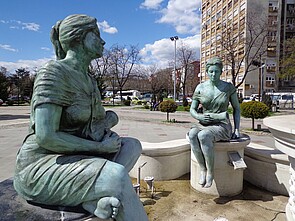
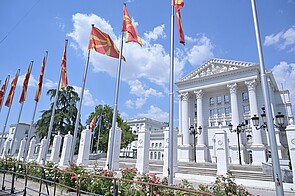
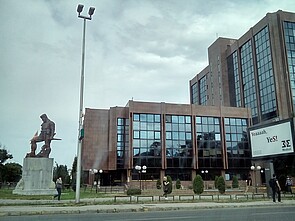
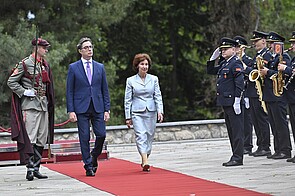
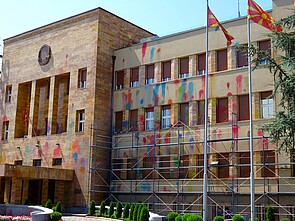
Goran Janev · 12.04.2015
Skopje 2014: Instrumentalizing Heritage for Unexpected Results
Read more
Get this article as PDF download (including pictures).